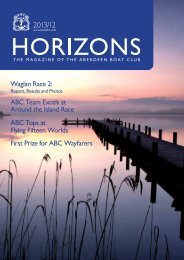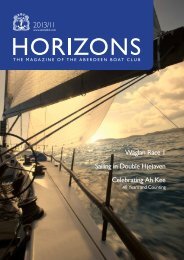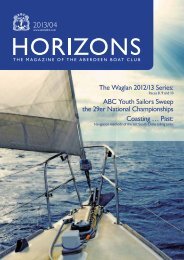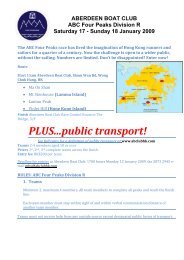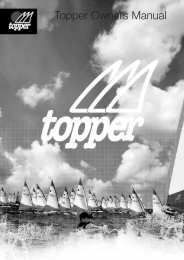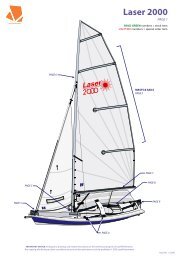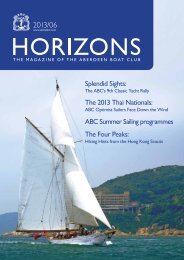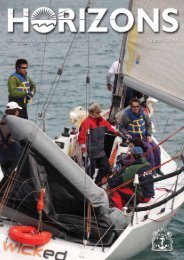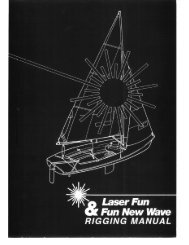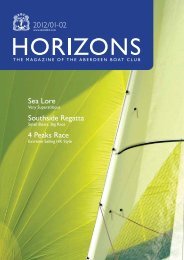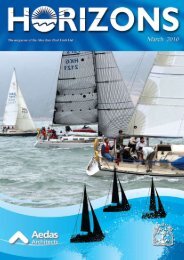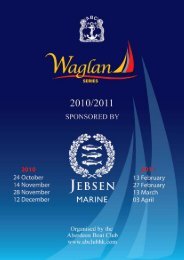Apr 2012 Issue - the Aberdeen Boat Club
Apr 2012 Issue - the Aberdeen Boat Club
Apr 2012 Issue - the Aberdeen Boat Club
Create successful ePaper yourself
Turn your PDF publications into a flip-book with our unique Google optimized e-Paper software.
P.18 Horizons <strong>2012</strong>/04 | ABC dinghy sailing handicap system<br />
ABC Dinghy Sailing<br />
ABC Handicap Adjustment System and Series Scoring<br />
Words by John Berry, Photo by Kevin Lewis<br />
In <strong>the</strong> last Horizons issue we were given a fine description of <strong>the</strong><br />
cruiser handicapping systems, both under IRC for measured<br />
boats giving a fixed adjustment number according to boat and<br />
rig configuration, and <strong>the</strong> HKPN for a performance adjusted<br />
handicap based on actual results. These two systems relate<br />
respectively to a boat’s potential, and to a boat and crew’s<br />
recent performance.<br />
For ABC Dinghy racing we also have two systems, reflecting<br />
our joint racing with RHKYC dinghies.<br />
Firstly, our joint racing is undertaken for all boats using<br />
numbers issued by <strong>the</strong> Hong Kong Sailing Federation (HKSF).<br />
For dinghies this is almost always based on Royal Yachting<br />
Association’s (RYA) Portsmouth Yardstick (PYS) numbers, few<br />
of which change per year, and marginally. Joint race results are<br />
calculated by dividing <strong>the</strong> elapsed time for each boat by its HKSF<br />
number for <strong>the</strong> particular boat, <strong>the</strong>n multiplying by 1000, giving a<br />
corrected time from which <strong>the</strong> final order of finishers is derived.<br />
HKSF numbers range from around 924 for 29ers, to 1084 for<br />
Laser 1s, to 1260 for Picos. This method gives results based on<br />
boats’ potential speeds.<br />
For our ABC club results, we run a modified form of this<br />
method, whereby we have a boat handicap, as in joint racing, to<br />
which is added a ‘skipper handicap’. The skipper handicap can<br />
be positive or negative, and is a cumulative number of past race<br />
results where an adjustment is made after each race as follows:<br />
• First place – subtract 10 points (i.e. approx 1%)<br />
• Second place – subtract 5 points<br />
• Second last – add 5 points<br />
• Last – add 10 points<br />
The club results are <strong>the</strong>n calculated by dividing <strong>the</strong> elapsed<br />
time for each boat by its HKSF number PLUS its skipper<br />
handicap, <strong>the</strong>n multiplying by 1000, giving a corrected time,<br />
from which <strong>the</strong> final order of finishers is derived. Thus a skipper<br />
may change boats mid-season and have his results calculated<br />
using his Adjustment Number plus <strong>the</strong> HKSF number of <strong>the</strong><br />
new boat.<br />
Sound simple? Fortunately we have Sailing Secretary Angela<br />
Ho to calculate it all on a spreadsheet.<br />
For Series Scoring, we adopt <strong>the</strong> ISAF’s (International Sailing<br />
Federation) Low Point System, where <strong>the</strong> winning boat is given a<br />
score of 1, second place 2, and so on. Results for <strong>the</strong> series shall<br />
be calculated after discarding <strong>the</strong> worst scores according to how<br />
many races have been held in <strong>the</strong> series (normally two or three),<br />
and <strong>the</strong> boat with <strong>the</strong> lowest score wins!<br />
Now you know how it works, let’s see you on <strong>the</strong> course for<br />
<strong>the</strong> next dinghy races on <strong>Apr</strong>il 1st, 15th, 29th and May 20th.



